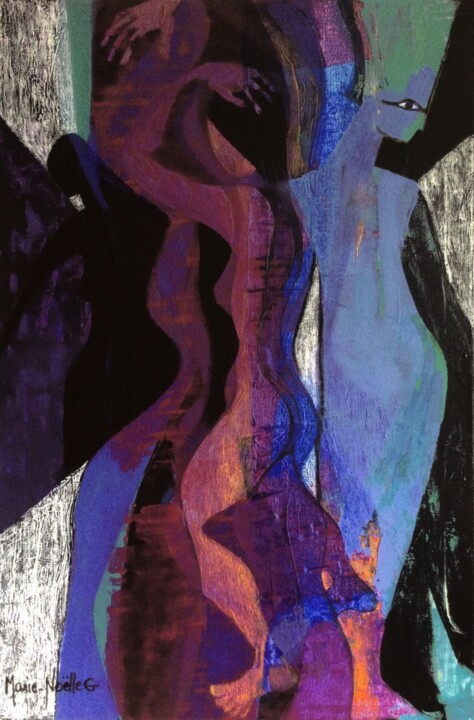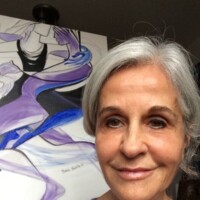Marie-Noëlle Gagnan
Interview pour Art Platform NYC 2015
1) How did you become an artist, and did you know early on that you would be in the arts, or did you begin as something else? Were there other artists in your family?
Even as a child, I loved drawing. One of my teachers who taught a drawing class also encouraged me a lot. Once I finished my high school studies, I went to the École Supérieure des Arts Appliqués, in Paris, which is where I got to be definitively convinced that I wanted to pursue a career in arts. And though we can indeed say that there are some talented artists in my family, as well as some others that are interested by art, I am the only one who decided to work in this discipline.
2) Each artist is so different when it comes to approaching their work. How do you approach your creation- can you elaborate on your working process?
For each and every of my paintings, I start by getting acclimated to my canvas. One stroke leads to another and, little by little, I confide in my canvas. Soon, a dialogue begins: secrets are shared from both sides and the feeling of solitude vanishes. The painting, alive, responds to me, suggests ideas. From time to time, these ideas are surprising, yet the exchange stays dynamic. I do not feel alone anymore, and my passion for pictorial discourse reveals its very depth.
3) What are the primary themes of your work?
I am captivated by the depth of the self. The themes I capture are about the mysteries of the soul, about light and darkness; they rest upon a civilization, rich elements of silent stories that stir up emotions. Through my dreamlike canvasses, both symbolic and expressionistic, I share a corner of my soul, hoping to reach a corner of yours.
4) Who are your favorite artists and why?
I have always had a strong preference for fauvism and expressionism. The contrast between pure and complementary colours gives birth to a powerful expression. Subtler notes suggest a mystery both complex and inaccessible. Also, colours and symbols can give rise to emotions. The reason why I like expressionism is because it has the power to make us escape from objective realism, to make us rediscover the emotion inside and amplify it.
5- Why do you think art is important for the world, and why is it important for you as an individual artist?
In today’s world, we neglect too often the importance of art: we consider it unnecessary even though it is part of our needs. Art is a medium for communication (sharing ideas, emotions and aestheticism). Most importantly, it lets us express things we could never express otherwise. Art is about the soul, about what can be felt; there is no word for it. For me, as an artist, art is life. Art allows me to break free from an otherwise down-to-earth everyday life, explore new horizons, avoid the stress usually caused by our lifestyles. When I enter my workshop, intending to work, I immediately let go, I throw myself entirely in this adventure, in these mysterious lands. Which is not to say that all is always easy.
6- What do you hope to communicate to the viewer and how does this specifically effects the final result?
My first goal is to express an emotion I feel emerging within myself exactly as I feel it, then to be able to share it. Depending on my theme, it could be a mood in a given situation, either happy or sad, a dreamlike vision, a memory. I then choose, depending on what I’m painting, bright or dark colours, a sharp or flexible drawing style, abstraction or figuration, and, most importantly, symbols.
7- Which of your artwork pieces is your favorite, or have been most significant to you as an artist?
The pieces I feel have the most meaning, for me, are those that best translate my feelings. Every time I look at one of my paintings, in order for me to be satisfied, it has to recreate – with enough intensity – the very same emotion. Composition and colour harmony are also important elements. However, I cannot choose a favourite painting, because each of them has its own distinctive characteristics.
8-What is the biggest frustration for you being an artist?
I have a hard time tolerating the idea that the first criteria for selection by the Conseil des Arts du Québec have nothing to do with art.
9- How do you feel when people interpret your artwork differently, or is there one primary thing you hope to have the viewer experience?
Everyone can have his own interpretations. Most of the time, I hear what I expect. When I hear something different, I get curious; I love listening to comments or interpretations I’d never have imagined. Sometimes, an interpretation seems so interesting to me that I feel I even learned something. When I suggest something in a painting, it can give birth to new ideas which can vary from person to person. For me, that’s another mystery!
10-What advice do you have for aspiring artists?
Work, work and work, work relentlessly every day. Persevere. Do not get discouraged by failures, do not get influenced by other people. Listen to your own inner world. Work always bears fruit!


